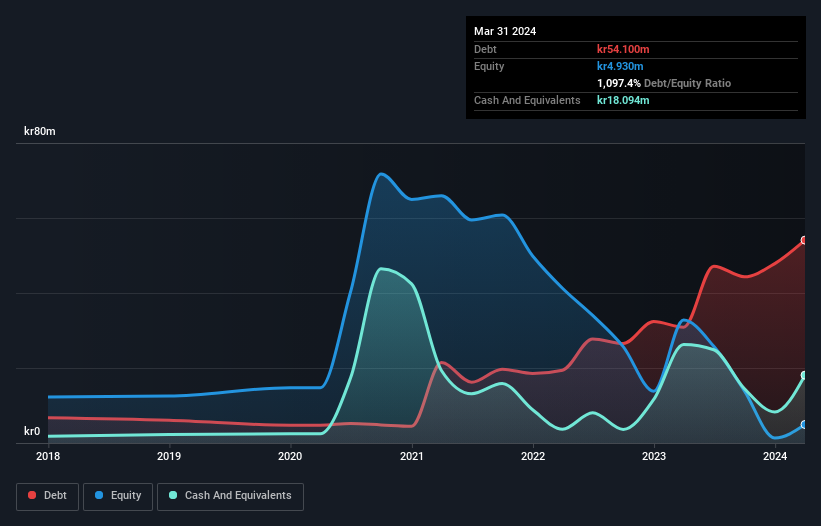LifeClean International (STO:LCLEAN) Is Making Moderate Use Of Debt
Howard Marks put it nicely when he said that, rather than worrying about share price volatility, 'The possibility of permanent loss is the risk I worry about... and every practical investor I know worries about.' When we think about how risky a company is, we always like to look at its use of debt, since debt overload can lead to ruin. Importantly, LifeClean International AB (publ) (STO:LCLEAN) does carry debt. But should shareholders be worried about its use of debt?
When Is Debt Dangerous?
Debt and other liabilities become risky for a business when it cannot easily fulfill those obligations, either with free cash flow or by raising capital at an attractive price. In the worst case scenario, a company can go bankrupt if it cannot pay its creditors. While that is not too common, we often do see indebted companies permanently diluting shareholders because lenders force them to raise capital at a distressed price. Of course, plenty of companies use debt to fund growth, without any negative consequences. The first thing to do when considering how much debt a business uses is to look at its cash and debt together.
See our latest analysis for LifeClean International
What Is LifeClean International's Net Debt?
You can click the graphic below for the historical numbers, but it shows that as of March 2024 LifeClean International had kr54.1m of debt, an increase on kr30.9m, over one year. However, it does have kr18.1m in cash offsetting this, leading to net debt of about kr36.0m.

How Strong Is LifeClean International's Balance Sheet?
Zooming in on the latest balance sheet data, we can see that LifeClean International had liabilities of kr56.1m due within 12 months and liabilities of kr20.5m due beyond that. Offsetting these obligations, it had cash of kr18.1m as well as receivables valued at kr9.73m due within 12 months. So it has liabilities totalling kr48.8m more than its cash and near-term receivables, combined.
Since publicly traded LifeClean International shares are worth a total of kr327.7m, it seems unlikely that this level of liabilities would be a major threat. However, we do think it is worth keeping an eye on its balance sheet strength, as it may change over time. When analysing debt levels, the balance sheet is the obvious place to start. But ultimately the future profitability of the business will decide if LifeClean International can strengthen its balance sheet over time. So if you want to see what the professionals think, you might find this free report on analyst profit forecasts to be interesting.
In the last year LifeClean International wasn't profitable at an EBIT level, but managed to grow its revenue by 14%, to kr54m. That rate of growth is a bit slow for our taste, but it takes all types to make a world.
Caveat Emptor
Over the last twelve months LifeClean International produced an earnings before interest and tax (EBIT) loss. Its EBIT loss was a whopping kr48m. Considering that alongside the liabilities mentioned above does not give us much confidence that company should be using so much debt. So we think its balance sheet is a little strained, though not beyond repair. Another cause for caution is that is bled kr44m in negative free cash flow over the last twelve months. So suffice it to say we consider the stock very risky. When analysing debt levels, the balance sheet is the obvious place to start. However, not all investment risk resides within the balance sheet - far from it. These risks can be hard to spot. Every company has them, and we've spotted 5 warning signs for LifeClean International (of which 2 are significant!) you should know about.
If, after all that, you're more interested in a fast growing company with a rock-solid balance sheet, then check out our list of net cash growth stocks without delay.
New: AI Stock Screener & Alerts
Our new AI Stock Screener scans the market every day to uncover opportunities.
• Dividend Powerhouses (3%+ Yield)
• Undervalued Small Caps with Insider Buying
• High growth Tech and AI Companies
Or build your own from over 50 metrics.
Have feedback on this article? Concerned about the content? Get in touch with us directly. Alternatively, email editorial-team (at) simplywallst.com.
This article by Simply Wall St is general in nature. We provide commentary based on historical data and analyst forecasts only using an unbiased methodology and our articles are not intended to be financial advice. It does not constitute a recommendation to buy or sell any stock, and does not take account of your objectives, or your financial situation. We aim to bring you long-term focused analysis driven by fundamental data. Note that our analysis may not factor in the latest price-sensitive company announcements or qualitative material. Simply Wall St has no position in any stocks mentioned.
About OM:LCLEAN
LifeClean International
LifeClean International AB (publ) researche, produces, markets, and sells disinfection products in Sweden and internationally.
Moderate risk and slightly overvalued.
Market Insights
Community Narratives




